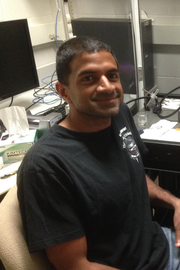
In response to cholinergic stimulation by the sympathetic nervous system, the adrenal gland releases catecholamines and neuropeptides into the circulation. These transmitters modulate the activity of a variety of important tissues in the body, including the heart and lungs. The secretory function of the adrenal gland becomes vital during the “fight-or-flight” response as the body reacts to challenges posed by a changing environment. The Anantharam laboratory is interested in understanding the cellular and molecular events involved in the secretion of catecholamine and protein molecules. For this reason, the Lab focuses on the mechanisms controlling large dense core granule exocytosis in the chromaffin cell, located within the adrenal medulla.
Despite the fact that many of the molecular players in exocytosis have been identified, there remain significant gaps in the Lab’s understanding of their precise roles. For instance, it is known that the SNARE (soluble n-ethylmaleimide-sensitive fusion protein attachment protein receptor) proteins are required for the initial fusion of granule and plasma membrane bilayers. This creates a continuous aqueous passage, or fusion pore, for the movement of granule contents out into the extracellular space. But the expansion of the pore and the eventual fate of the granule after fusion (i.e., local recycling or alternatively, collapse into the plasma membrane) appear also to be regulated by other elements. A better molecular understanding of these issues is directly relevant to knowing how, and how much, neurotransmitters and hormones are released into the circulation with every granule fusion event.
Using a combination of high-resolution electrophysiological and optical techniques and empowered by our access to new genetic animal models of secretion, the research of the Anantharam Lab focuses on three major areas:
Because many of the general rules governing exocytosis in the chromaffin cell also appear to apply to other cell types (e.g., neurons, pancreatic beta-cells), the Lab anticipates that its findings will be of broad relevance and interest. Over the long-term, the Lab hopes to develop a framework to understand how exocytosis is regulated to maintain heath, and how this regulation is compromised during neurological and endocrine diseases.
Source: http://clasweb.clas.wayne.edu/anantharam